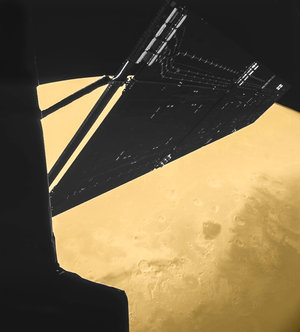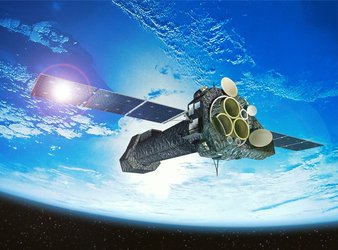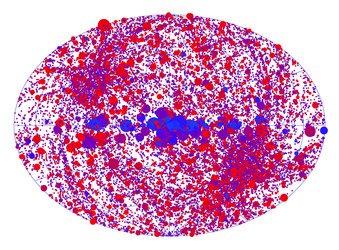Accept all cookies Accept only essential cookies See our Cookie Notice

About ESA
The European Space Agency (ESA) is Europe’s gateway to space. Its mission is to shape the development of Europe’s space capability and ensure that investment in space continues to deliver benefits to the citizens of Europe and the world.
Highlights
ESA - United space in Europe
This is ESA ESA facts Member States & Cooperating States Funding Director General Top management For Member State Delegations European vision European Space Policy ESA & EU Space Councils Responsibility & Sustainability Annual Report Calendar of meetings Corporate newsEstablishments & sites
ESA Headquarters ESA ESTEC ESA ESOC ESA ESRIN ESA EAC ESA ESAC Europe's Spaceport ESA ESEC ESA ECSAT Brussels Office Washington OfficeWorking with ESA
Business with ESA ESA Commercialisation Gateway Law at ESA Careers Cyber resilience at ESA IT at ESA Newsroom Partnerships Merchandising Licence Education Open Space Innovation Platform Integrity and Reporting Administrative Tribunal Health and SafetyMore about ESA
History ESA Historical Archives Exhibitions Publications Art & Culture ESA Merchandise Kids Diversity ESA Brand Centre ESA ChampionsLatest
Space in Member States
Find out more about space activities in our 23 Member States, and understand how ESA works together with their national agencies, institutions and organisations.
Science & Exploration
Exploring our Solar System and unlocking the secrets of the Universe
Go to topicAstronauts
Missions
Juice Euclid Webb Solar Orbiter BepiColombo Gaia ExoMars Cheops Exoplanet missions More missionsActivities
International Space Station Orion service module Gateway Concordia Caves & Pangaea BenefitsLatest
Space Safety
Protecting life and infrastructure on Earth and in orbit
Go to topicAsteroids
Asteroids and Planetary Defence Asteroid danger explained Flyeye telescope: asteroid detection Hera mission: asteroid deflection Near-Earth Object Coordination CentreSpace junk
About space debris Space debris by the numbers Space Environment Report In space refuelling, refurbishing and removingSafety from space
Clean Space ecodesign Zero Debris Technologies Space for Earth Supporting Sustainable DevelopmentApplications
Using space to benefit citizens and meet future challenges on Earth
Go to topicObserving the Earth
Observing the Earth Future EO Copernicus Meteorology Space for our climate Satellite missionsCommercialisation
ESA Commercialisation Gateway Open Space Innovation Platform Business Incubation ESA Space SolutionsEnabling & Support
Making space accessible and developing the technologies for the future
Go to topicBuilding missions
Space Engineering and Technology Test centre Laboratories Concurrent Design Facility Preparing for the future Shaping the Future Discovery and Preparation Advanced Concepts TeamSpace transportation
Space Transportation Ariane Vega Space Rider Future space transportation Boost! Europe's Spaceport Launches from Europe's Spaceport from 2012Latest

XMM-Newton self-portraits with planet Earth
Thank you for liking
You have already liked this page, you can only like it once!
This series of images was taken 15 years ago, a couple of months after the launch of ESA’s XMM-Newton space observatory. These unique views, showing parts of the spacecraft main body and solar wings, feature a guest of honour – Earth – which crosses the field of view from left to right, as the satellite slews across our planet.
Launched on 10 December 1999, XMM-Newton is an X-ray observatory, designed to investigate some of the most violent phenomena in the Universe. Sources that emit large amounts of X-rays – radiation with very high energy – include remnants of supernova explosions and the surroundings of black holes.
Detecting this energetic radiation is a daunting endeavour, requiring techniques that are greatly different from those used in traditional telescopes. In the case of XMM-Newton, it carries a science module with three telescopes consisting each of 58 nested mirrors. These sit at one end of a 7 m-long tube, while at the other end is the focal plane with the scientific instrumentation.
In addition, the spacecraft was also equipped with two Visual Monitoring Cameras, mounted outside the instrument module and looking along the tube towards the mirror module and solar wings. The cameras, named Fuga and Iris, respectively, were used by the flight control team to check how the solar wings unfolded after launch.
About two months later, on 16 February 2000, the two cameras were being tested, as part of the spacecraft commissioning phase. Incidentally, the spacecraft was slewing across our planet at the time, at an altitude between 45 000 km and 50 000 km.
As a result, Fuga took this fascinating series of what would now be called ‘space selfies’, depicting parts of the tube, service module and solar wings in front of a half-Earth. Interestingly, some of the views show hints of our planet’s stormy atmosphere, a barrier to highly energetic light and the very reason why X-ray observatories like XMM-Newton have to be operated in space.
At the time when these images were taken, XMM-Newton was on its 35th revolution around Earth. More than 15 years later, it has now completed over 2800 revolutions, obtaining a wealth of cutting-edge data that are being used by astronomers worldwide and have produced over 4000 scientific publications so far. One of these images was originally published in February 2000.
-
CREDIT
ESA/XMM-Newton -
LICENCE
ESA Standard Licence

Rosetta’s self-portrait at Mars

XMM-Newton

Reflecting on XMM-Newton

Sources in XMM-Newton’s second slew catalogue















 Germany
Germany
 Austria
Austria
 Belgium
Belgium
 Denmark
Denmark
 Spain
Spain
 Estonia
Estonia
 Finland
Finland
 France
France
 Greece
Greece
 Hungary
Hungary
 Ireland
Ireland
 Italy
Italy
 Luxembourg
Luxembourg
 Norway
Norway
 The Netherlands
The Netherlands
 Poland
Poland
 Portugal
Portugal
 Czechia
Czechia
 Romania
Romania
 United Kingdom
United Kingdom
 Slovenia
Slovenia
 Sweden
Sweden
 Switzerland
Switzerland

























